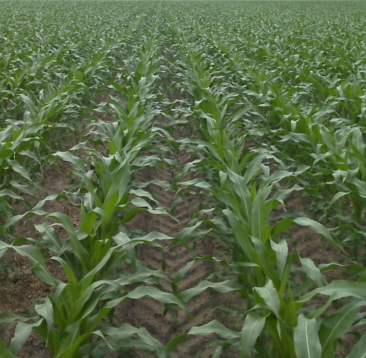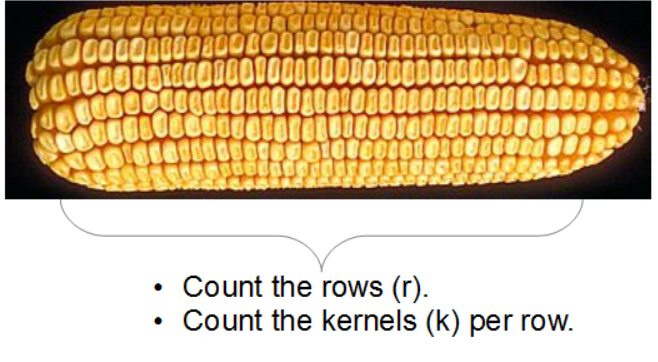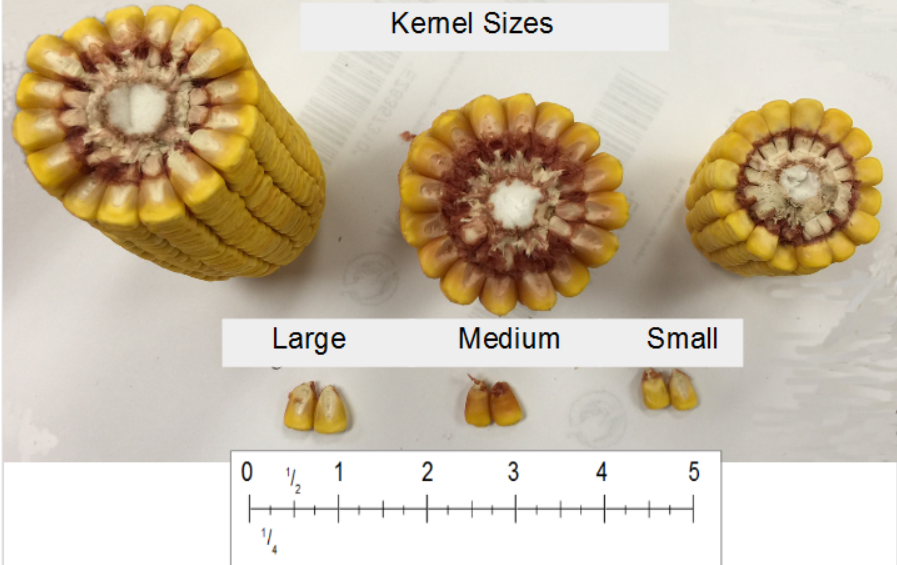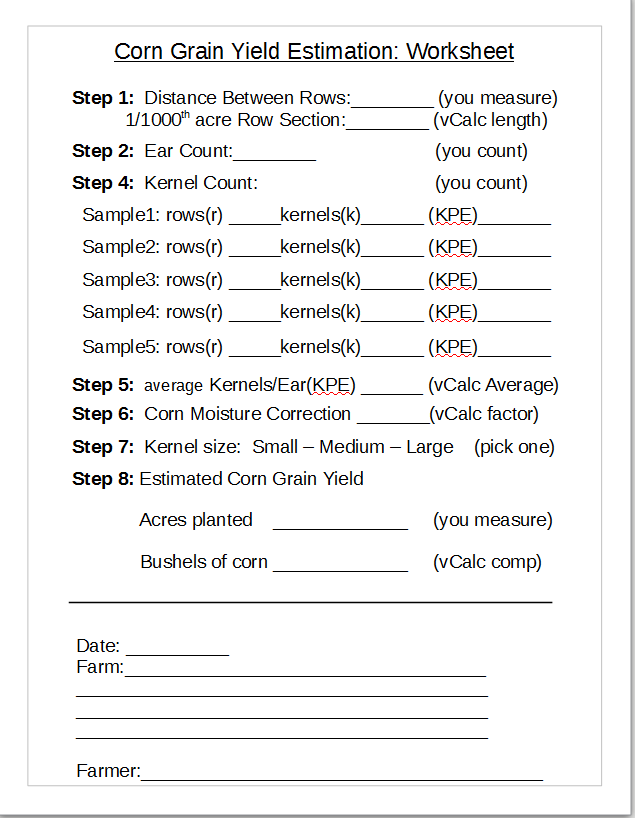Corn Grain Yield Estimation Calculator
| Corn Yield Quick Guide | |||
| Step | Action | Calculator | |
|---|---|---|---|
| 1 | Measure 1/1000th acre row | 1/1000 acre row | |
| 2 | Count Ears in Row | NONE | |
| 3 | Pick 5 Ears for Sample | NONE | |
| 4 | Count the Kernels per Ear | Kernels per Ear | |
| 5 | Average kernel count of 5 ears | Average KPE | |
| 6 | Compute Moisture Correction | Corn Moisture Correction | |
| 7 | Estimate Kernel Size | NONE | |
| 8 | Compute Corn Yield for Total Acreage | Corn Yield Estimate |
Well before harvest, it's possible to estimate the yield of corn you'll realize in grain from your fields. This web page does two things. First it contains step by step instructions, and second it will actually do the math for you via embedded calculators. You will see those calculators at the right time in the instructions and they will pop-up when you click on the right words, usually in bold like these e.g. Kitchen Units Conversion. Enter your numbers, and let the calculators do your math.
The general concept of estimating Corn Yield is pretty easy, and this page really helps with the math. First you will take a measured sample of your corn. The sample will match an area of your field that will then be used to estimate the entire field. In the process, we'll use some science (moisture correction), some statistics (averages of samples) and good old fashioned geometry to turn the observation of 1/1000th of an acre into an estimate for your entire field. But don't worry about the math. We're here to help you with that part. You'll only have to do the instructions and enter your numbers. We'll do the calculating and give you your yield estimate. Let's get started.
Step One - Row Section
The most common method for yield estimation relies on taking a good sample of the ears and kernels from one small section of your field, typically 1 / 1000th of an acre. We'll help you get the right size (length of a row of corn), but you need to be smart and make sure that the row is comparable to the other rows in your field. You know the things that can affect your corn. Pick a row where the conditions are average, not on an edge of your field where sunlight might be different, or at low spot where water may be different, nor a spot that's more or less rocky than the rest of the field. You get the idea.
So the first step is to compute the length of one row for the sample. All you need for this is the measurement of the distance between the rows. With that measurement, we'll tell you how long the portion of the row will need to be to create an observation of 1 / 1,000th of an acre.  Corn Row Spacing
Corn Row Spacing
Step One - Measure the distance between your Rows, and COMPUTE 1/1000th ACRE ROW HERE. This will tell you the length of the row of corn to use for your sample. We are going to call this the Row Section. Once you know that length, mark the beginning and end of your Row Section. This is where you'll take your sample.
Step Two - Ear Count
Now, go through your Row Section, and count the number of ears of corn that you believe will be harvest-able and write down that number. We call it the Ear Count. You know your combine, so you should be able to judge which ears your combine will retrieve.
Step Three - Ear Sample
Now, go back through your Row Section and pick five (5) average looking harvestable ears. These shouldn't be overly small or old ears unless that's the true nature of your corn.
Step Four - Kernel Count
Take those five ears and count the havestable kernels. The harvestable kernels are those that your combine will take of the cob, not on the tips (pinched ends). The easiest method is to count the rows of kernels (not the ends) and multiply that by the number of kernels per row (COMPUTE KERNEL COUNT HERE). Write down the Kernel Count for the five sample ears. You'll need those numbers on for the next step. Method to count the kernels in an ear of corn.
Method to count the kernels in an ear of corn.
Step Five - Average Kernels Per Ear
The next step is to compute the average number of kernels per ear. Take the five observations and enter them into this calculator (COMPUTE AVERAGE HERE). This will provide you with the average (mean) number of Kernels Per Ear (KPE). Write that number (KPE) down. At this point, we could multiply the your KPE by the number of ears in your row (Ear Count), multiply that by 1,000, and then multiply that by the number of acres you have planted and you would have a good estimate of the number of kernels of corn your land will produce. But there are a few more factors that will affect the volume (bushels) of corn, your estimated yield. These factors are moisture content and kernel size.
Step Six - Corn Moisture Correction
The volume of your corn will vary based on the moisture content. A typical, market ready, 56lb bushel of corn will have a 15.5% moisture content. Depending on the current moisture content of your corn,  the volume and weight will be reduced in the final yield. To account for this, measure the moisture percent of your corn. There are moisture testers (e.g. Delmhorst or Koster) to do this, or you can measure moisture content using a good scale and a microwave (See detailed instructions HERE). Once you know your percent of moisture, compute the Moisture Factor:
the volume and weight will be reduced in the final yield. To account for this, measure the moisture percent of your corn. There are moisture testers (e.g. Delmhorst or Koster) to do this, or you can measure moisture content using a good scale and a microwave (See detailed instructions HERE). Once you know your percent of moisture, compute the Moisture Factor:
Step Six, calculate and write down your Corn Moisture Correction =`(100%?Wet%)/(100%?Dry%)`. Example: assuming the moisture is 30%, Corn Moisture Correction = (100-30)/(100-15.5) = 70/84.5 = .828.
Step Seven - Kernel Size
This size of your kernels will affect the yield estimation. The number of kernels per bushel can range from 120,000 kernel per bushel for small kernels to only 80,000 kernels per bushel for large kernels. Use the following guide (picture) to estimate the size category of your kernels (Small, Medium, Large)
Step Eight - Yield Estimation
You're almost done. So far, you've calculated the following:
- Ear Count - This is the number of ears of corn in your 1/1000th acre sample Row Section
- KPE - This is the average number of kernels per ear in your sample
- Corn Moisture Correction - This is the correction factor to account for the moisture in your corn sample
- Kernel Size - This is your estimation on the relative size of your kernels (Small,Medium,Large)
The last thing you need is the acreage planted (A). With these numbers you can estimate the number of bushels of corn in your crop.
Special Thanks to the Expert(s)
The above formulas and step by step process is based on information provided by Mr. Lantz (University of Maryland Extension Instructor) who provided the methods, tested the results and provided final review of this page. Information was harvested (pun intended) from his own experience and resources. For supporting information, consider the following: